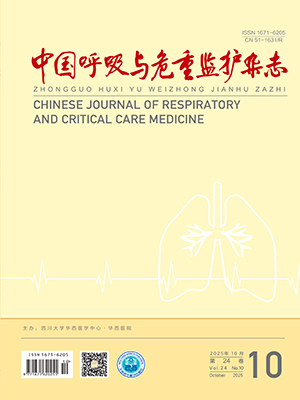| 1. |
Sinuff T, Cook DJ, Randall J, et al. Evaluation of a practice guideline for noninvasive positive-pressure ventilation for acute respiratory failure. Chest, 2003, 123(6): 2062-2073.
|
| 2. |
Bernstein G, Knodel E, Heldt GP. Airway leak size in neonates and autocycling of three flow-triggered ventilators. Crit Care Med, 1995, 23(10): 1739-1744.
|
| 3. |
Schettino GP, Tucci MR, Sousa R, et al. Mask mechanics and leak dynamics during noninvasive pressure support ventilation: a bench study. Intensive Care Med, 2001, 27(12): 1887-1891.
|
| 4. |
Vignaux L, Vargas F, Roeseler J, et al. Patient-ventilator asynchrony during non-invasive ventilation for acute respiratory failure: a multicenter study. Intensive Care Med, 2009, 35(5): 840-846.
|
| 5. |
Chen YQ, Cheng KW, Zhou X. Performance characteristics of seven bilevel mechanical ventilators in pressure-support mode with different cycling criteria: a comparative bench study. Med Sci Monit, 2015, 21: 310-317.
|
| 6. |
陈宇清, 程克文, 周新. 应用COPD模型比较系统泄漏对7款双水平正压呼吸机吸气触发同步的影响. 国际呼吸杂志, 2012, 32(24): 1870-1875.
|
| 7. |
Battisti A, Tassaux D, Janssens JP, et al. Performance characteristics of 10 home mechanical ventilators in pressure-support mode: a comparative bench study. Chest, 2005, 127(5): 1784-1792.
|
| 8. |
Ferreira JC, Chipman DW, Hill NS, et al. Bilevel vs ICU ventilators providing noninvasive ventilation: effect of system leaks: a COPD lung model comparison. Chest, 2009, 136(2): 448-456.
|
| 9. |
Stell IM, Paul G, Lee KC, et al. Noninvasive ventilator triggering in chronic obstructive pulmonary disease. A test lung comparison. Am J Respir Crit Care Med, 2001, 164(11): 2092-2097.
|
| 10. |
Mehta S, McCool FD, Hill NS. Leak compensation in positive pressure ventilators: a lung model study. Eur Respir J, 2001, 17(2): 259-267.
|
| 11. |
Vignaux L, Tassaux D, Jolliet P. Performance of noninvasive ventilation modes on ICU ventilators during pressure support: a bench model study. Intensive Care, Med, 2007, 33(8): 1444-1451.
|
| 12. |
Zhu KX, Rabec C, Gonzalez-Bermejo J, et al. Combined effects of leaks, respiratory system properties and upper airway patency on the performance of home ventilators: a bench study. BMC Pulm Med, 2017, 17(1): 145.
|
| 13. |
Richard JC, Carlucci A, Breton L, et al. Bench testing of pressure support ventilation with three different generations of ventilators. Intensive Care Med, 2002, 28(8): 1049-1057.
|
| 14. |
Keenan SP, Mehta S. Noninvasive ventilation for patients presenting with acute respiratory failure: the randomized controlled trials. Respir Care, 2009, 54(1): 116-126.
|
| 15. |
Carteaux G, Lyazidi A, Cordoba-Izquierdo A, et al. Patient-ventilator asynchrony during noninvasive ventilation: a bench and clinical study. Chest, 2012, 142(2): 367-376.
|
| 16. |
Scala R, Naldi M. Ventilators for noninvasive ventilation to treat acute respiratory failure. Respir Care, 2008, 53(8): 1054-1080.
|




